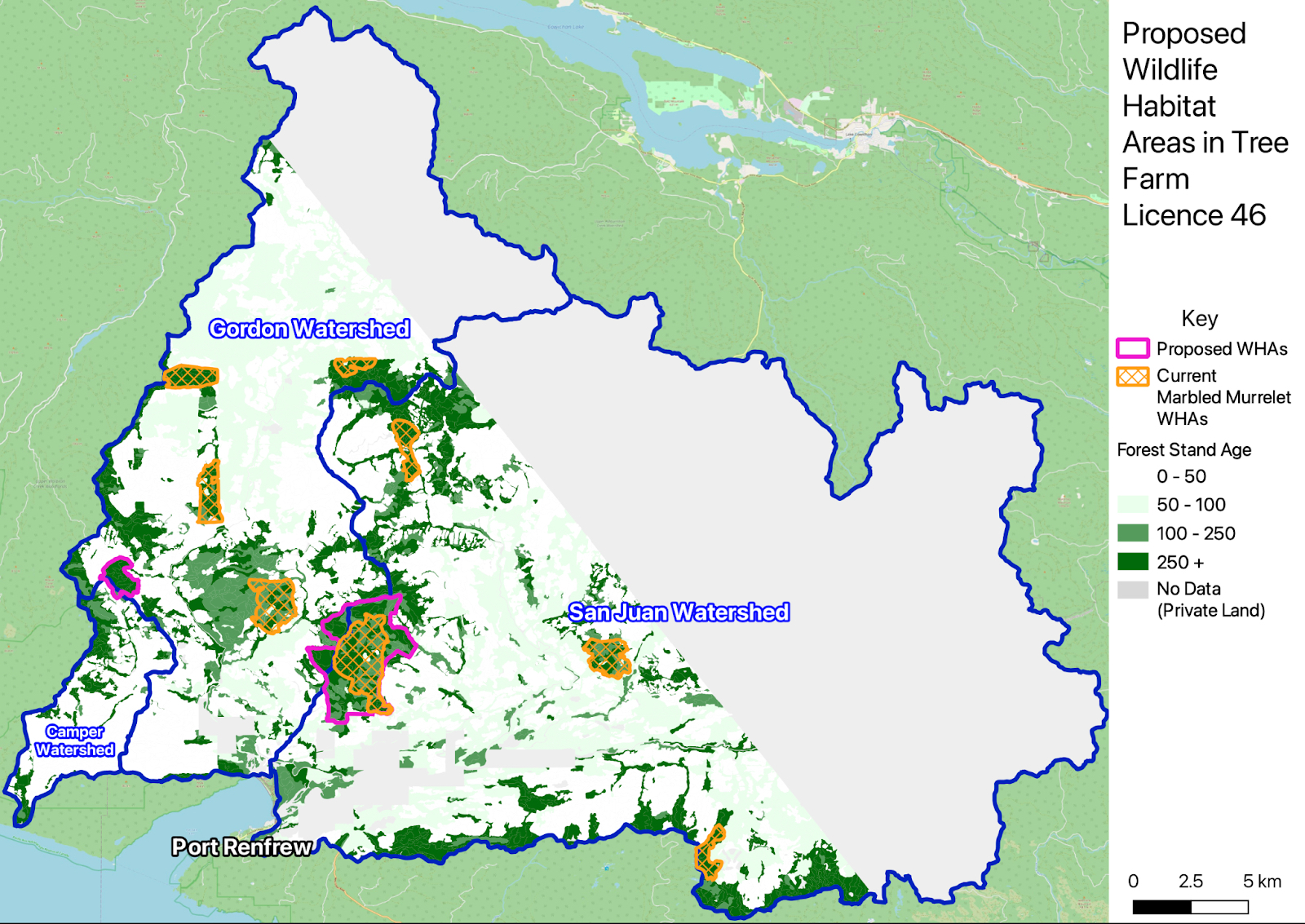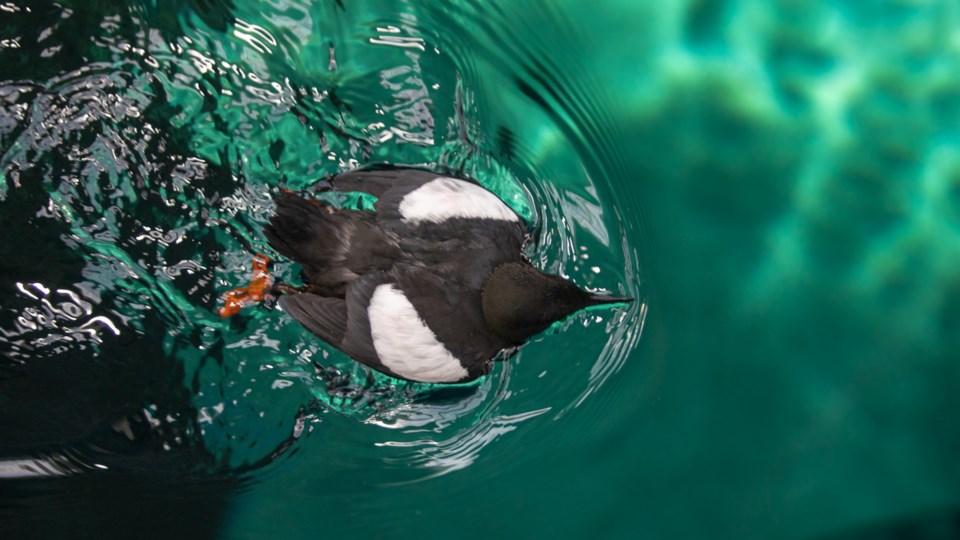Birders and biologists are banding together to urge the sa¹úŒÊŽ«Ãœ government to protect ancient forests on southwestern Vancouver Island in a bid to save threatened marbled murrelet nesting sites.
Around a dozen citizen scientists are documenting the, which raises its young in old-growth forest found in, which includes the Fairy Creek region near Port Renfrew, said team leader and avid birder Royann Petrell.
The Fairy Creek region was at the centre of a series of a couple years ago, with police making more than a thousand arrests at the site. The conflict peaked in the summer of 2021 and is believed to be the largest act of civil disobedience in Canadian history.
The team of birders has documented murrelets on more than 300 occasions in and around the Fairy Creek watershed, and recorded another 75 sightings in the Gordon and Camper Creek watersheds during the summer nesting season in 2021, Petrell said.
The citizen scientists, backed by four murrelet experts on both sides of the U.S.-sa¹úŒÊŽ«Ãœ border, are pushing the province to protect 996 hectares of old-growth from logging to enlarge or create new (WHAs) for the birds, which lay a single egg on large moss-covered branches of massive coniferous trees.
The proposal submitted in December suggests adding 828 hectares to an existing 603-hectare murrelet habitat area in Fairy Creek to protect nearly all the watershed as well as contiguous forests. The plan also proposes a new 168-hectare WHA in the Gordon and Camper watersheds.

Petrell, a retired University of British Columbia scientist who lives in the Comox Valley, visited Fairy Creek out of curiosity in 2021 when the blockades were underway, but never participated in the protests. During her initial visit, she heard western screech owls on several occasions and was motivated to discover what other species at risk of extinction existed in the region.
Over time and after she documented murrelets, more and more avian enthusiasts came on board, she said.
“We’re birders, not blockaders,” Petrell said. “We started recording [the murrelets] for proof, and more and more people joined me in doing it.”
Petrell said she noticed the didn’t include data on murrelets in Fairy Creek, so she decided she had better register her findings.
“The system is only useful if people put information in there,” she said.
Forestry companies, such as Teal Cedar, which controls TFL 46, are supposed to determine what threatened species are present in their region when developing logging plans, Petrell said.
But wildlife surveys aren’t actually required before logging gets underway, she added.
“That disturbed me,” Petrell said.
“I said to myself, if surveys aren’t required, I’d better do it because there is so little old-growth forest left.”
The province has confirmed it has received the proposed murrelet WHAs submitted by Petrell and her colleagues, but the government has provided no information on whether the proposal will be considered or timelines for a decision on potential action by the province.
The marbled murrelet is deemed to be vulnerable on a global scale, with all of sa¹úŒÊŽ«Ãœ’s population found only in sa¹úŒÊŽ«Ãœ It was, and reconfirmed as such in 2000 and again in 2012. The bird was registered under the federal Species at Risk Act in 2003.
Yet, the little bird’s plight has only worsened, not improved, over time, Petrell said.
The fast-flying birds, reaching speeds over 70 kilometres per hour, spend most of their time on water and feed on small fish near ocean shores but travel long distances inland to nesting sites.
Murrelets are secretive and very hard to spot, given they tend to fly in and out of forests in the hours before dawn; they are largely detected by sound or radar surveys, Petrell said.
The global population is found along the length of the North Pacific coast, but it is estimated to be between 263,000 and 841,000 birds, at least 50,000 of which are in sa¹úŒÊŽ«Ãœ.
They need tall trees greater than 250 years old because fledglings in particular aren’t great fliers and need a high jumping-off point and be able to avoid other trees to remain airborne, Petrell said.
“They have just one chance,” she said.
“If they touch the ground, they can't get up because their legs are not suitable for walking on land,” she said.
The greatest danger to the birds is the continued habitat loss of old-growth forests, estimated to be declining by more than 20 per cent for the last three generations of the birds. Other cumulative threats include increased shipping in coastal waters, being caught in fishing nets and changing marine conditions.
The murrelets’ most recent protection plan, , now outlines the need to also protect critical marine and terrestrial habitats.
But despite the birds’ long-standing threatened status, projected population losses are expected to exceed 30 per cent over the next three generations of the species.
Using the province’s latest 2019 murrelet habitat maps, Petrell has found there is a mismatch between the older, established wildlife habitat areas in TFL 46. On average, only 25 per cent of existing WHAs contain suitable nesting habitats.
The creation of the two new WHAs would help save a larger proportion of the old-growth nesting trees, she said.
A number of eminent conservation biologists — including Peter Arcese, who helped create previous murrelet recovery plans, and U.S. researcher Martin Raphael, who tracked birds south of the border migrating to the Fairy Creek forests — support the proposed wildlife areas, Petrell noted.
There is no valid rationale for continuing to cut old-growth stands on Vancouver Island, said Arcese, a forestry professor at the University of British Columbia, in a statement.
“Because [their] habitat is extremely rare in sa¹úŒÊŽ«Ãœ, every additional site that is lost reduces the likelihood that marbled murrelets will continue to persist in our region,” he said.

